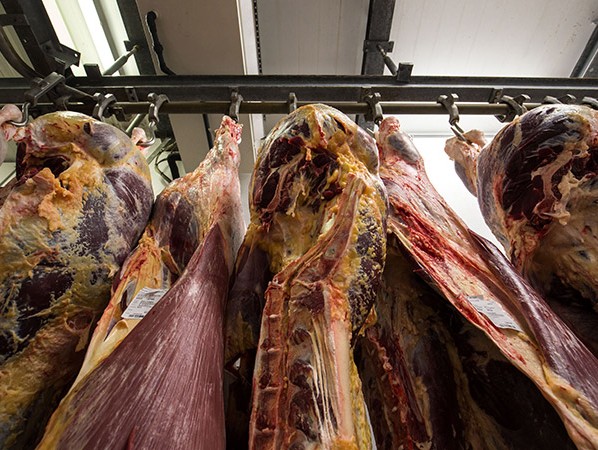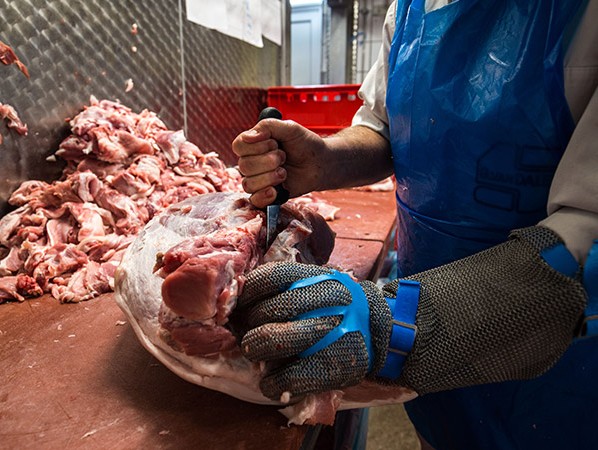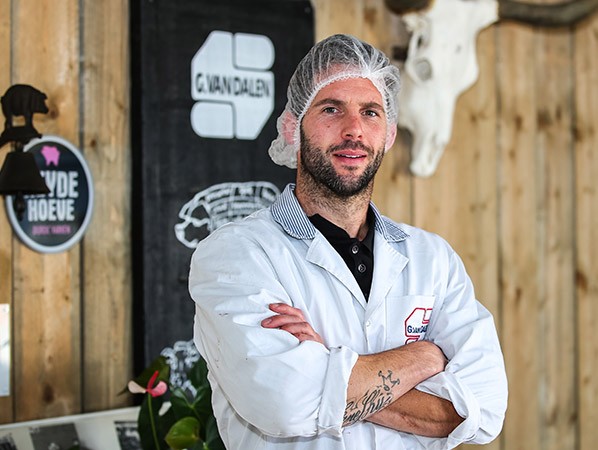
What are the daily activities and work methods at a medium-sized, artisanal meat processing company? Dick Wever, Executive Director of G. van Dalen's Vleescentrale, lets us look behind the scenes and shares his vision on meat and entrepreneurship.
Every Monday morning between 3:00 and 7:00 AM, the cattle arrive at G. van Dalen's Vleescentrale in Schagen. The cattle come from all parts of the Netherlands, from farmers who have the best interest of their animals at heart. For Dick Wever, it is an absolute requirement that the cattle are fed on the right fodder, that they have outdoor pasture time and sufficient indoor space with straw bedding, good lighting, and air circulation. "When an animal is not been made comfortable, you will not get a nice piece of meat. Impossible!"
The hours between five and seven in the morning are hectic at Van Dalen. Dick: "The cattle go to the straw corner to recuperate from the journey. Then they are sedated, slaughtered, and brought to the cold store. After that, we start processing the meat. We can deliver the meat in any way the butchers want it. We also supply pork, although we don't slaughter the pigs ourselves. We use, for example, pork from the Heyde Hoeve pigs, which are Duroc pigs and known for their succulent and juicy meat. We are the butchers' right hand. They all have their specific requirements. Our strength lies in the fact that we can meet those requirements.
Dick has been the Executive Director of G. van Dalen's Vleescentrale since 2015. "It was always my dream to run a company such as this", he says. "That is why I wanted to be familiar with all aspects of the meat business and learn as much as possible in practice. From the slaughtering to the preparation of high-end caterer products. I worked and did traineeships at as many different places, from large supermarket chains to the most luxurious butcher shops in Amsterdam and with culinary companies such as Runderkamp in Volendam. This broad experience gave me a good insight into the different processes.

When Dick is asked to name one thing that makes his company unique, it is the preparation of sausages. "We are constantly thinking of new recipes: from liver sausage specialities to grilled sausages with sambal, leek, and cheese. There is nothing we won't try. And we work with very exact recipes, so our clients get their products with a constant taste and consistency, as it was meant to be in the first place. We have clients who place relatively small orders of around fifty kilos to clients for whom we prepare a few tons of sausages. As a medium-sized company, we have this flexibility."
After working in the sausage preparation for two years, Dick thought it was time for a next step. His ambition goes beyond just making sausages and he gets the opportunity to make his dream come true. Over the past years, the company has only grown. This also means that changes in the operational processes become inevitable. "When I started, the sausage company produced five hundred kilos a week. Now, this is sometimes more than ten tons. In total, we deliver more than forty tons of meat a week. That also required more automated processes and structure. One of the most important elements is the labelling of products in order to trace them. We have a good automation system to add codes to products and to give them batch numbers. This way, we can always ascertain from which animal a packaged piece of meat originates from."
At the same time, Van Dalen is and remains an artisanal business. "Nearly everything we do is done by hand. For us, 'artisanal' means that meat gets the time it needs to become what it must be. Pulled pork must hang in the smoking cupboard for at least sixteen hours. And a smoked sausage must have been smoked for a minimum of five hours, with real smoke!" According to Dick, excellent meat, the right herbs and spices and preparation, but also the intuition and sensitivity during the preparation process are what determines the quality of your product.

Not just the operational processes are constantly under development, the consumer changes as well. Today's trend is: less is more: the purer the meat, the better. "People eat less meat. But when they do, they consciously go for a higher quality. In the old days, côte de boeuf and rib roast were seldom sold. Nowadays, butchers sell it regularly." He also notices that there is an increasing demand for vegetarian alternatives for meat. "On the one hand, I'm open to anything and I did experiment with producing a meat substitute. On the other hand, I think: 'Stick to your trade'. We are meat specialists."
G. van Dalen's Vleescentrale is doing very well. The company is still growing and the current location is getting too small. At his office, Dick has the design drawings of the intended rebuilding works. "I want to implement even more structure into our processes and we want a high-care area, allowing us to work according to even higher hygiene standards." For him, it is all about innovation. Whether it is the rebuilding of the premises or trends and developments. "I'm always looking around, visit other companies to gain more knowledge. I try out new things and read a lot; from professional magazines to cookbooks."
"The best thing of my work is collaborating with different people", says Dick. For instance, we developed a number of new products with barbecue chef Jord Althuizen. These kinds of initiatives bring knowledge and innovation to your company. But the most important lesson I learned as a director of Van Dalen is that you have to take good care of your employees. When your staff feels comfortable and in the right place, it will ultimately result in an even better piece of meat on the consumer's plate.
Source: © Fotoburo Roel Dijkstra